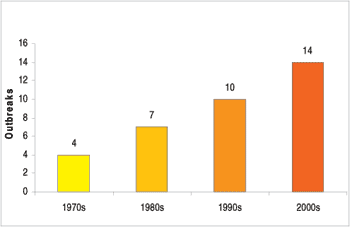
CSPI’s analysis shows a steady increase of such outbreaks in every decade since the 1970s, though that may be due to increased testing and reporting, says the CSPI researchers. In its study of 35 documented outbreaks, raw milk, raw milk cheeses and ground beef appeared to carry the resistant pathogens most frequently.
Multi-drug resistance was found in 10 out of 14 outbreaks of antibiotic-resistant foodborne illness reported between 2000 and 2009, according to the study. CSPI says the problem of antibiotic-resistant bacteria needs much greater scrutiny by the federal government if antibiotics are to remain effective in treating human and veterinary illnesses.
Cataloging outbreaks of foodborne illness and then testing the pathogens for antibiotic resistance is a critical step if policymakers are to document the link between antibiotic use on farm animals and human illness from antibiotic-resistant bacteria, says the study. Unfortunately, information on outbreaks of foodborne illness due to antibiotic-resistant bacteria is limited. Salmonella and E. coli are not routinely tested for antibiotic resistance, and even when tests are performed, results are not required to be reported to CDC.
CSPI researchers documented through literature searches a total of 35 foodborne outbreaks between 1973 and 2009 in which the bacteria identified were resistant to at least one antibiotic. The report illustrates the link between foods, mostly of animal origin, and outbreaks of antibiotic-resistant pathogens in humans. The report emphasizes this is not an “emerging problem, but an established problem” that needs more routine scrutiny by public health officials.
The National Antimicrobial Resistance Monitoring System (NARMS) collects data on patterns of emerging resistance from pathogens. The data is not linked to actual outbreaks. Also, CDC does not track and publish outbreaks on sporadic illnesses caused by resistant bacteria, as it does for pathogens in its FoodNet system. The CSPI study links together this information in a preliminary database to show what could be accomplished should a public health agency integrate the data.
A total of 19,897 people were sickened in 35 outbreaks during the 1970s through the 2000s. These illnesses resulted in 3,061 hospitalizations and 26 deaths. The data includes one large Salmonella Typhimurium outbreak caused by milk in 1985 in which 16,659 were sickened, 2,777 were hospitalized and 18 died.
For more information on antibiotic-resistant bacteria, references and a compendium of the data described above, download the CSPI study.

